It is the year 100 A.D. Trajan is now the emperor of Rome, and everyone wants to be on his good side. You are a secret society member, manipulating the Senate with influence over various factions. Some of those deals are a bit shady, but as long as you’re not as corrupt as your competitors, you may still come out ahead.
At a glance: 100 A.D. is for 3 to 6 players, ages 13 and up, and takes about an hour to play (though playing time varies based on number of players). It is currently seeking funding on Kickstarter (just launched this morning), with a $60 pledge for a copy of the game. There’s nothing risque in the game but there are terms like blackmail, abduction, and assassination used in the game, so use caution if you don’t want to explain those to your younger kids. The game isn’t hard to learn, but because it is a longer game with a lot of direct conflict, I would recommend it for more experienced players.
New to Kickstarter? Check out our crowdfunding primer.
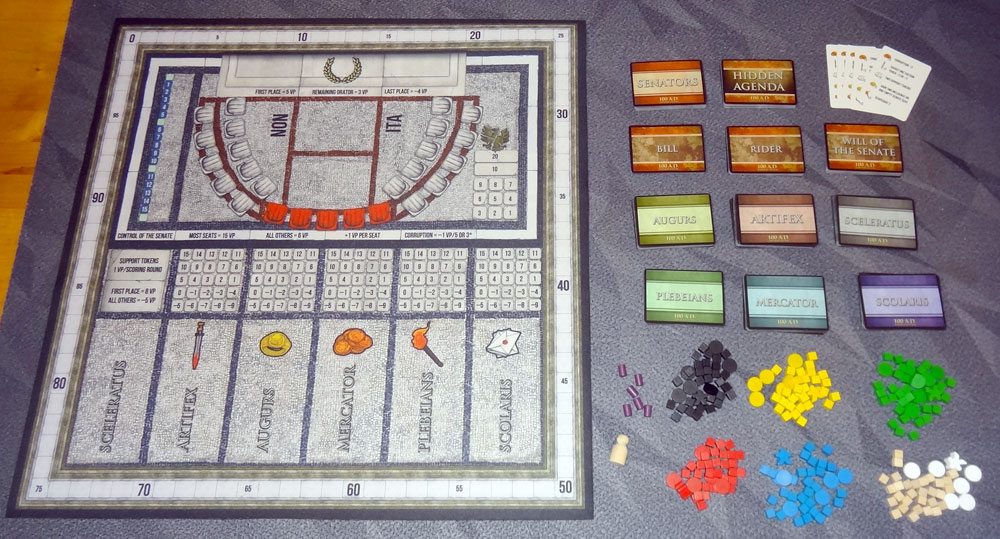
Components:
- Game board
- 1 turn order tracker token
- 5 faction tracker tokens
- 6 sets of influence tokens (30 per color, 6 colors)
- 6 sets of support tokens (6 per color, 6 colors)
- 6 Faction decks (30 cards each)
- 30 Senator cards
- 30 Hidden Agenda cards
- 30 Will of the Senate cards
- 45 Bill cards
- 45 Rider cards
Note: I received a prototype of this game for review, but it was an earlier draft so final components will differ from this. However, I expect that the overall look will remain similar. The photos in this post are a mix of the prototype and the “Emperor’s Edition” deluxe version.
The game board is made to look like the floor of the Roman Senate: seats arranged in a semicircle facing the front of the Senate, with a courtyard area behind that. There’s a section for each faction deck (with a little space for influence cubes) and some faction scoring tracks. On one side of the Senate there’s a turn track, and on the other is the Corruption track. A score track goes around the entire perimeter of the board. I really like the overall look of the board, with the tile mosaic floor and the top-down view of the seats.

There are some scoring reminders here and there on the board, but the first few times you play you’ll probably want to refer to the rulebook anyway. The Corruption track is a little hard to read at a glance: there are boxes for 1-9, and two larger boxes for 10 and 20. The idea is that you put one cube down if you have between 1 and 10 Corruption. At 11, you’ll need to add another cube. And at 31 you’ll add yet another (one on the 20, one on the 10, and one on the 1). It makes sense, but if you glance over at that section of the board and there are a bunch of different colored cubes, it’s not immediately obvious who’s ahead.
The other thing about the numbering is that (at least on my copy of the board) the numbers increase from right to left, which is counterintuitive. I’m hoping that’ll get reversed in the final game. I’m glad they didn’t decide to use Roman numerals for everything, at least.
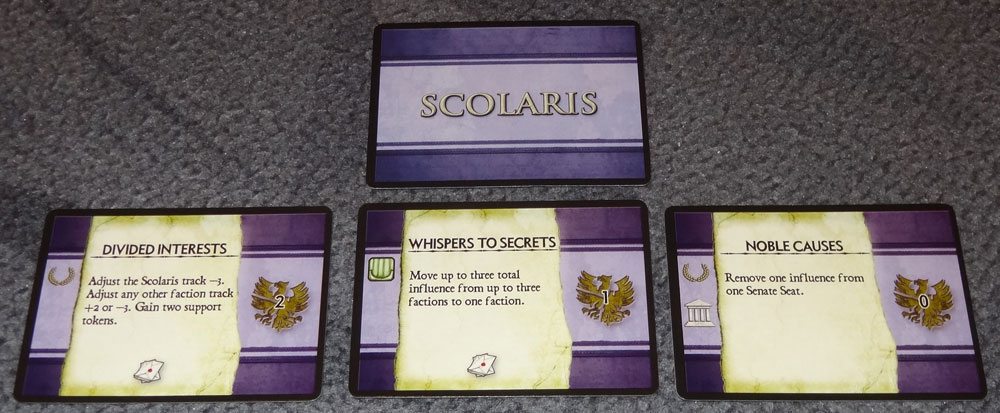
Each of the factions has a deck of cards. Each card has a title, and could contain some icons on the left, some text in the middle, intrigue icons at the bottom, and a broken eagle icon at the right. Generally when you use a card, you go from left to right, top to bottom, resolving everything in order. Or, if you use a card for its intrigue icons, you don’t use it for anything but the icon.
It’s interesting to me that there are so many Bills and Riders. There are 45 of each, but generally you only need three of each per game. That’s a whole lot more variety than seems necessary, but I guess with 7 billion different possibilities, you don’t have to worry about repeating yourself.
The backs of the cards are fairly plain, at least in the prototype: just a colored border with the deck name on the back.
How to Play
The object of the game is to score the most points after three scoring sessions (Recess). You earn points by gaining the Emperor’s favor, and controlling Senate seats. Corruption may cost you points. Having control over various factions may earn or lose points, depending on whether the faction is currently in favor with the Emperor.
To set up the game, place the board in the center of the table, with the turn order marker on the blank space before “1” and the five faction tracker markers on the “5” space of each track.

Each of the decks should be shuffled individually. Faction decks are placed on the board on the appropriate spaces; all other decks are set to the side of the board. One Bill and one Rider are revealed in the space on the Senate floor. Three Senators are revealed by the side of the board.
Each player takes all the pieces of one color. In a 5- or 6-player game, each player removes 6 influence markers, which won’t be used in the game. Each player takes 3 Hidden Agenda cards and selects one to keep. Each player may choose to keep one additional Hidden Agenda card at the cost of 3 Corruption. When the game starts, nobody has any of their support tokens yet, so they are set to one side.
The game starts with a Turn 0: players take turns placing influence cubes on the board until everyone has placed 5 cubes. You may place cubes onto a faction, a Senate seat, or the Emperor’s Favor space. The player with the most influence on Emperor’s Favor becomes the Orator (ties are broken randomly), immediately takes 1 support token, and adjusts one faction track +2 or -2. Everyone draws cards from the factions where they have placed influence, one card per influence Then Round 1 begins.
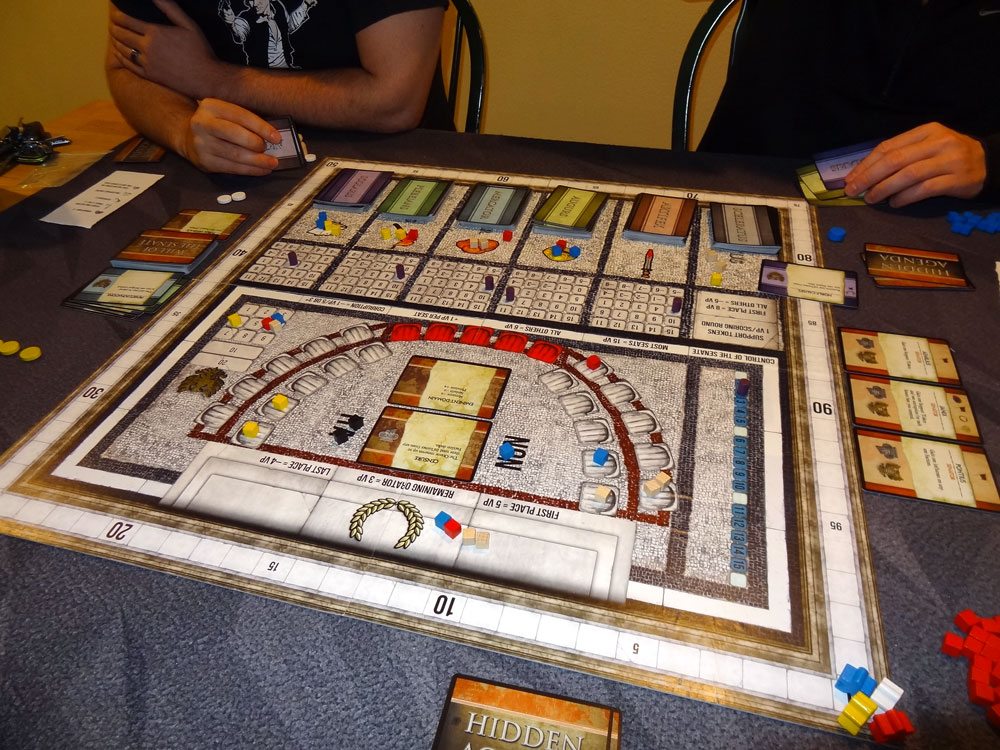
The game takes course over 15 rounds of play; after every 5 rounds, there is a Recess during which the pending bill is resolved and scoring occurs. The round starts with the current Orator, and proceeds clockwise.
On your turn, you get one action from the following choices. You may also spend 1 support token to take an additional action, but only once per turn.
- Contact a faction (place cubes to draw cards)
- Call in a favor (play a card)
- Control a senator (spend intrigue icons to use a senator card)
- Subterfuge (spend intrigue icons for special effects)
- Remove influence (remove your cubes from the board)
Contact a faction: You may place 1 or 2 cubes onto various factions in order to draw 1 card per cube from the matching factions.
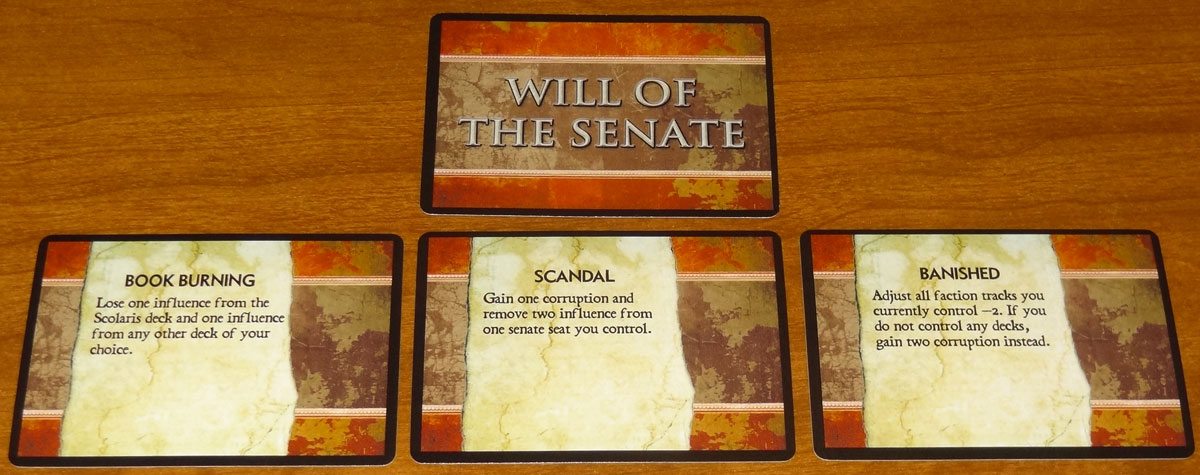
Call in a favor: You play a card from your hand for its effect. Cards have various icons that may force you to draw a Will of the Senate card (usually bad for you) allow you to gain Emperor’s Favor, vote on the pending bill, and gain or lose Corruption, in addition to their stated effects. Many cards manipulate influence among the factions or the faction scoring tracks. Others may allow you to gain support tokens.
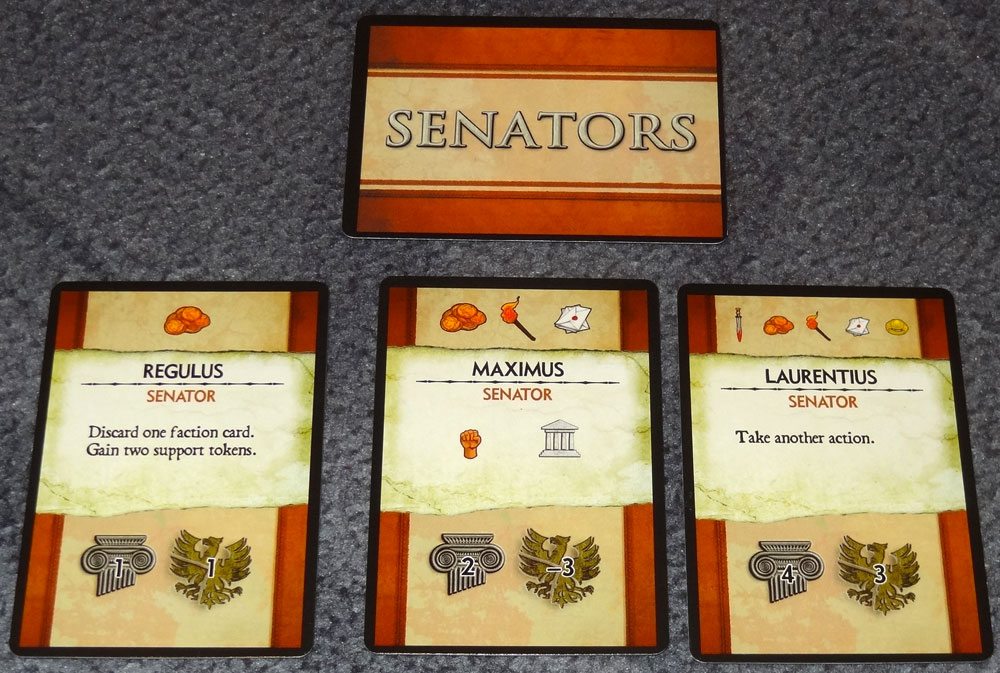
Control a senator: If you have cards matching the icons at the top of a senator card, you may discard them to control that senator. Do what the card says, and then you place the indicated number of influence cubes on an empty Senate seat, and gain or lose the indicated amount of Corruption.
Subterfuge: You may discard cards showing two matching intrigue icons for a special effect. Coins let you reduce Corruption. Daggers let you adjust a faction scoring track up or down. Torches let you Scapegoat–lose Corruption and force somebody else to gain it. Letters give you support tokens. Rings let you influence a Senate seat.
Remove influence: Since your pool of influence is limited, sometimes you’ll need to retrieve some in order to have something to spend. You may remove two of your influence tokens from anywhere on the board (except the Corruption track) for free, and additional tokens at a cost of 1 card each.
Every five rounds, there is a Recess.

During Recess, players will get a chance to perform one additional action at the cost of 3 Corruption. Then each player must remove one of their own influence from a faction other than Sceleratus (the criminals). Then the Orator resolves the pending bill by counting the votes (including the votes printed on the card)–ties go to “no.” If the bill passes, the Orator does its action, and then also adjusts faction tracks according to the rider. All influence tokens spent as votes are returned to their owners. The player with the most Emperor’s Favor becomes the new Orator–ties go clockwise from the Orator. Being Orator twice in a row is worth 3 VP.
Then, there is a scoring round. Players will earn points for having the most Emperor’s Favor, having any Senate seats, having the most Senate seats, having unused support tokens, and having the most influence over the Sceleratus faction. The player with the least Emperor’s Favor will lose points. Players with Corruption will lose points–the player with the most will lose the most points, and the player with the least will not lose any. For the faction tracks, the player with the most influence over each faction will gain or lose points based on the faction’s current scoring position. Any player who does not have the most influence on the Sceleratus track loses points.
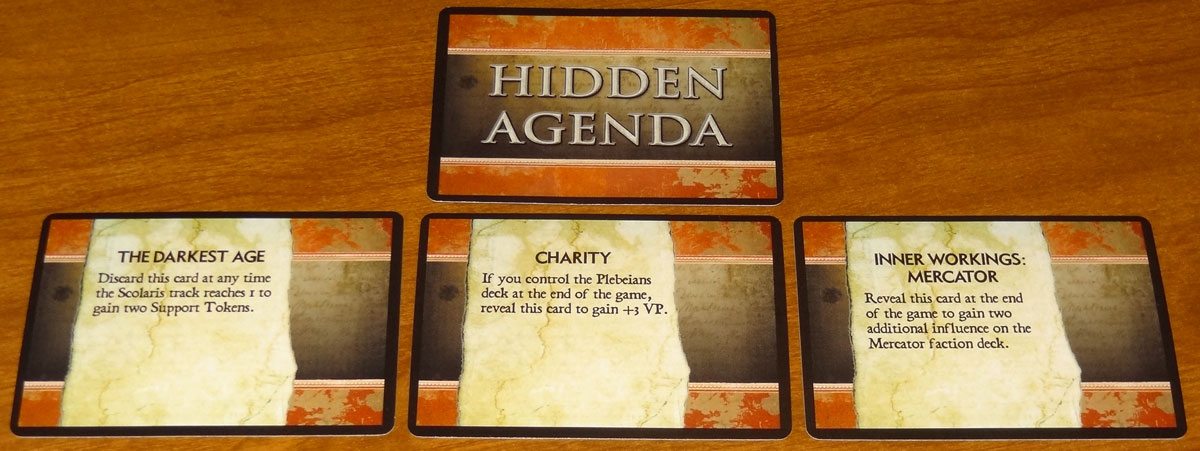
Each player then draws a Hidden Agenda card, and may gain 3 Corruption to keep it, or else discard it. Finally, each player draws one faction card from a faction where they currently have influence.
For the last Recess at the end of the game, players will not draw new Hidden Agenda cards. Instead, they are revealed in turn order just before the pending bill is resolved. Hidden Agenda cards may let you gain influence on a faction, or score points if you’ve managed to accomplish a particular mission.
The player with the most points after the final Recess wins.
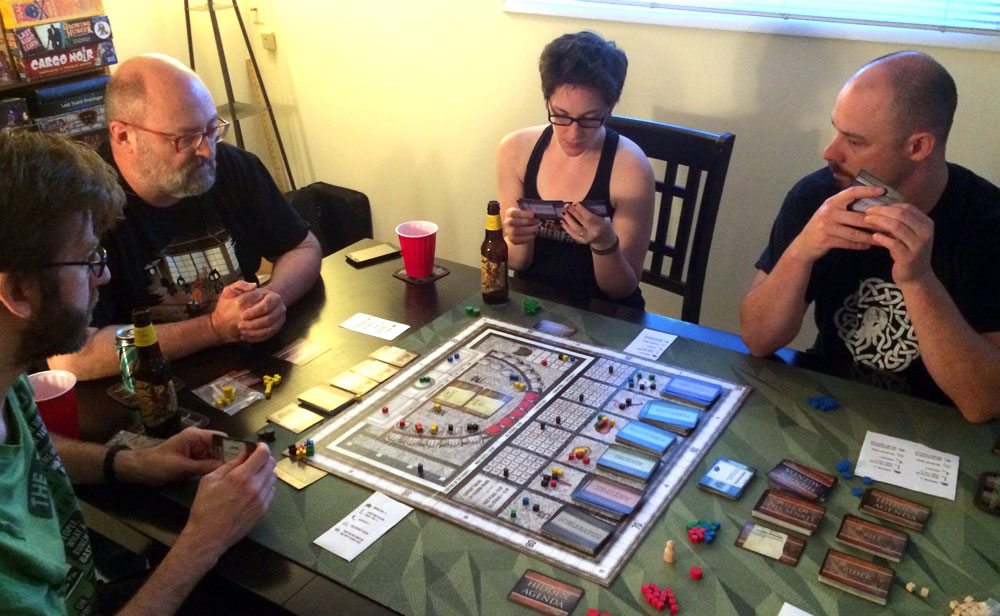
The Verdict
I first heard about 100 A.D. at GameStorm earlier this year, where I played a prototype with the designer, Jim Pinto, and I thoroughly enjoyed it. It has a whole lot of backstabbing and maneuvering to stay ahead, and the way that your scores swing back and forth feels like watching popularity polls during election season. The funny thing is that, although Pinto approached the game without inserting a “lesson” about politics, the way it plays out is pretty similar to real politics: the debate happening on the Senate floor about the bill, which appears to be central to the game, is really not the focus. It’s all the back-alley deals and whispered meetings that go on behind the scenes. I suppose you could call this game a prequel to House of Cards.
I mean, the whole game is about voting on three bills (and their respective riders), but in many cases only some of the players care about the bill itself. What really matters is gaining the Emperor’s favor, or controlling the Senate, or making sure that you have the most influence over the Sceleratus, because nobody wants to be on the wrong side of those criminals.

And, sure, some actions are corrupt, but as long as you’re not as corrupt as your opponents, you come out looking pretty good, right?
I like the way that influence over the various non-criminal factions works. Whoever has the most influence will score for the faction–but that may be positive or negative. So if your opponent has control over a faction, you have two options: fight for control, or decrease the faction’s score. If you play your cards right, you can lower the score, incite your opponent to pull influence out of that faction, and then raise the score back up just in time for Recess.
There’s a nice balance between the Corruption and the power of the cards. If you’re the least corrupt, you don’t have to worry about losing any points for it, but otherwise you want to make the most of your shady dealings. It’s not impossible to win without being at least a little corrupt, but it’s hard. Likewise, taking too much Corruption can work against you–though there is a Hidden Agenda card that actually gives you extra points at the end for being corrupt enough.
And the game’s rules don’t even get into negotiation between players, but of course that can lead to some great interactions, too. Just like Congress, you can make deals with each other: “I’ll support this bill if you help me take out Steve’s influence over the Mercator.” Just watch your back.
As far as the appearance goes, I really like the look of the board, though the trackers could use a little tweaking in my opinion. The cards are serviceable, if a little bland-looking.
The gameplay, however, is intense and a lot of fun. While it is a longer game, I found myself engaged throughout because even when you’re waiting for somebody to take their turn, what they do may very well influence you, so you’re paying attention. Plus, you might want to sway them in a different direction if you see them acting against you. This game is all about player interactions and competition, both direct and indirect, so if you’ve got a gaming group that’s highly competitive, this is a great choice.
For more information, visit the 100 A.D. Kickstarter page.
Disclosure: I received a prototype of this game for review.
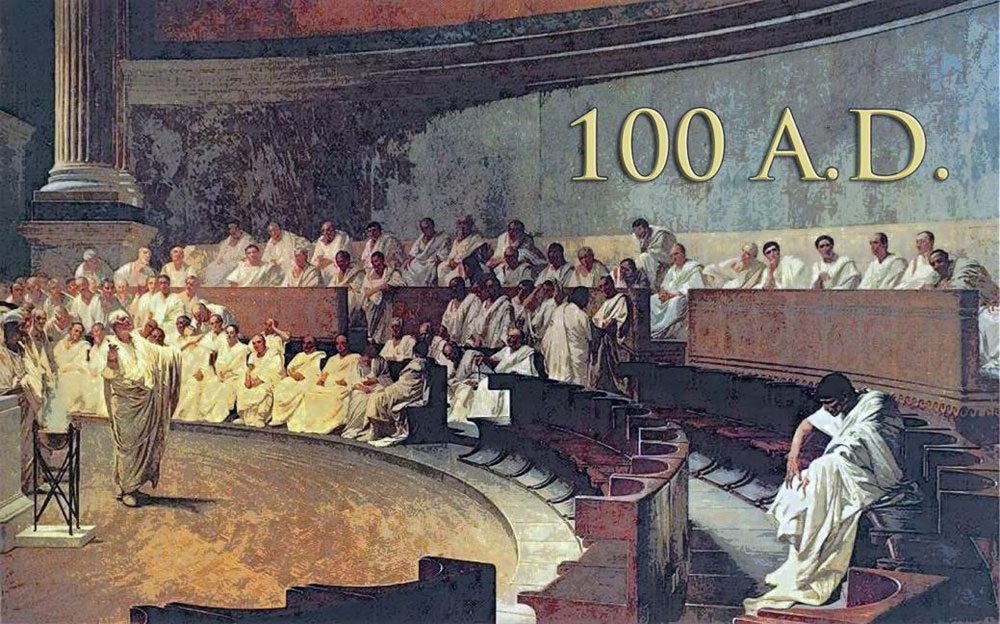





Seems very similar to “Trajan”, a top-25 strategy game (as ranked on board game geek). Almost too similar…
I would say it may share a lot thematically, but mechanically it looks like a completely different game. Trajan has a Mancala-like system; this one uses a lot of card effects and hidden information, and often uses the mechanic of taking on corruption points in exchange for power.